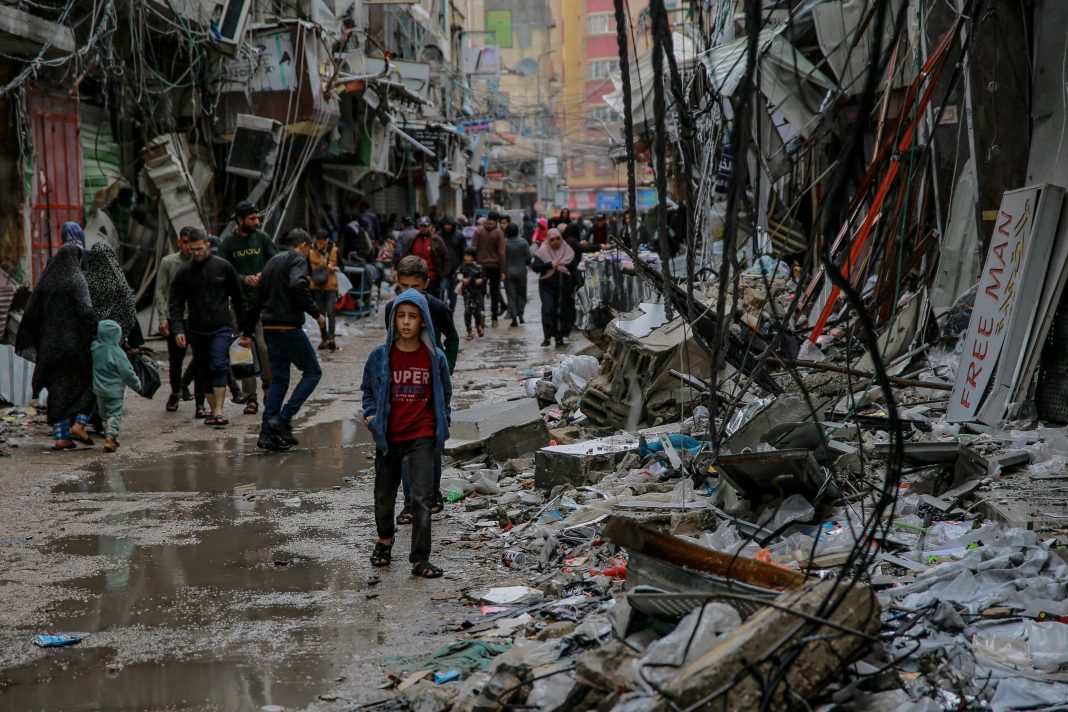In the heart of Gaza City, the remnants of buildings lie scattered, a stark reminder of the ongoing conflict that has claimed countless lives. On November 27, 2023, the devastation was palpable as Palestinians navigated through the debris, a scene that has become all too familiar in the occupied territory. Meanwhile, across the border in Tel Aviv, concerns were mounting over a potential Iranian missile strike targeting the headquarters of Mossad, Israel’s state intelligence agency. CNN reported that this facility is situated in a densely populated civilian area, raising questions about the implications of such strategic placements in urban environments.
The term “human shields,” a phrase that resonates deeply in the context of this conflict, was notably absent from the coverage. This omission is emblematic of a broader narrative that has persisted for decades: Israel’s justification for the high civilian toll in Gaza, which it attributes to Hamas’s choice to operate within civilian infrastructure. According to this narrative, the casualties are not victims of military aggression but rather the unfortunate collateral damage of Hamas’s tactics.
This framing has significant consequences. In the current escalation, over 40,000 Palestinians have reportedly lost their lives, with a tragic majority being women and children. These statistics are not just numbers; they represent lives cut short, families shattered, and communities devastated. As a Palestinian journalist from Gaza, I have witnessed firsthand the toll of this narrative. My own family has been touched by this violence; my mother, a dedicated United Nations worker, and my sister, a compassionate physiotherapist, were both killed in the conflict. They were civilians, not combatants, yet their deaths were subsumed under the label of “human shields” that the media often employs.
The concept of “human shields” is not new, nor is it exclusive to one side of the conflict. Historically, it has been weaponized in various geopolitical contexts. For instance, during the Vietnam War, the Viet Cong were accused of using civilians as shields, a narrative echoed by U.S. leaders to justify military actions. Similarly, President George W. Bush cited Saddam Hussein’s use of civilians in this manner to garner support for the Iraq War. Such rhetoric serves to dehumanize the affected populations, reducing them to mere pawns in a larger geopolitical game.
In the case of Israel, the situation is further complicated by the actions of its military. Reports from past conflicts, such as the 2014 ground invasion of Khuza’a, reveal instances where Israeli forces have employed Palestinian civilians as human shields. Ahmad Abu Rida, a 16-year-old boy, was forced at gunpoint to search for alleged Hamas tunnels, a harrowing experience that left him traumatized. This tactic, which violates international law as outlined in the Geneva Conventions, underscores the moral complexities of the conflict.
The media’s portrayal of these events often reflects a double standard, particularly in Western outlets. While Israeli officials, including Prime Minister Benjamin Netanyahu, have accused Hezbollah of using civilians as human shields, similar accusations against Israel are conspicuously absent. This selective language perpetuates a narrative that privileges Israeli lives over Palestinian ones, reinforcing a perception that Palestinians are less than human—mere obstacles in a military strategy.
As the conflict continues to unfold, it is crucial to challenge these narratives and recognize the humanity of all individuals affected by the violence. The term “human shield” should not be wielded as a weapon to justify the loss of innocent lives. Instead, it should prompt a deeper examination of the ethical implications of military strategies that place civilians in harm’s way, regardless of their nationality.
In conclusion, the ongoing tragedy in Gaza and the surrounding regions calls for a reevaluation of how we discuss and report on these issues. The lives lost are not simply statistics; they are stories of resilience, suffering, and the quest for dignity in the face of overwhelming adversity. It is imperative that the media, policymakers, and the global community acknowledge this reality and strive for a more nuanced understanding of the complexities at play. Only then can we hope to foster a dialogue that prioritizes peace, justice, and the protection of all civilians caught in the crossfire.


